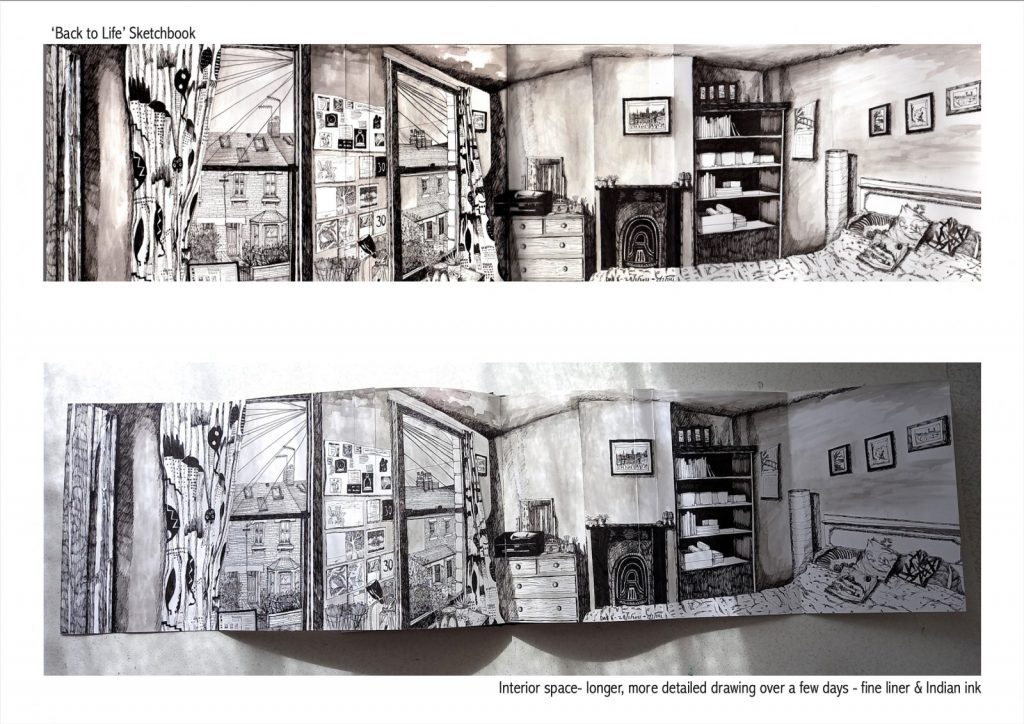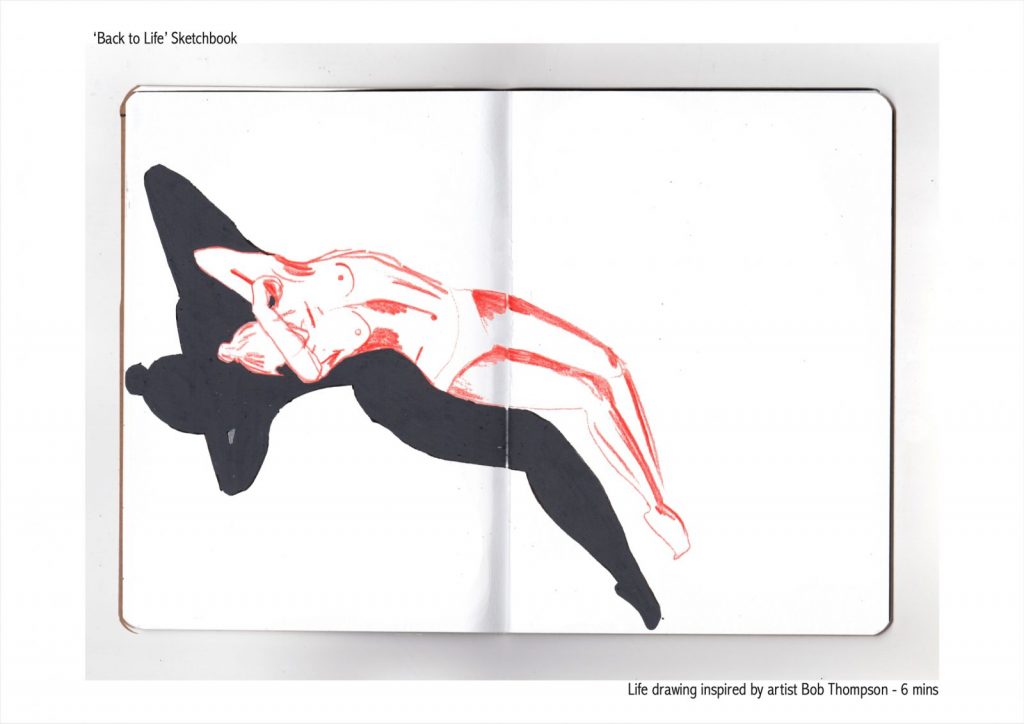In the latest episode of #NWConnect, gallery manager Nicky Laird chats to artist Charlotte Orr, whose exhibition Sunday Afternoon can be seen at The North Wall from 7 – 24 July 2021.
The exhibition features observed, composed and imagined landscapes, from the bracing Irish hills to the turquoise Cornish sea. Charlotte’s vibrant and intricate visual language is her response to the world around her and a visual diary of memories, experiences and stories from her mind’s eye.
Podcast Transcript
Download #NWConnect Charlotte Orr Podcast Transcript
Kim Glassman 0:00
Hello and welcome to North Wall Connect
Amelia Thornber 0:02
A new podcast series, where we chat with amazing artists featured here at The North Wall Arts Centre.
Kim Glassman 0:06
Brought to you by your hosts, Kim.
Amelia Thornber 0:08
And Amelia.
Nicky Laird 0:12
Today we are speaking to Charlotte Orr about her exhibition “Sunday Afternoon” which will open at The North Wall on the 7th of July. Charlotte is presenting a collection of drawing for this showcase of her work. The exhibition features observed, composed and imagined landscapes from the bracing Irish hills to the turquoise Cornish sea. Charlotte’s vibrant and intricate visual language is her response to the world around her and a visual diary of memories, experiences and stories from her mind’s eye. The stillness of a Sunday afternoon is the perfect time for Charlotte to delve into her artwork and inner world. It’s important to note that Charlotte would like to dedicate her exhibition to her father who died recently. Currently studying an MA in Illustration at Falmouth University, the exhibition will also give an insight into some of her most recent projects inspired by her studies. Welcome, Charlotte.
Charlotte Orr 1:05
Thank you. Hi, Nicky, thanks for the introduction.
Nicky Laird 1:08
Can we start with the title of your exhibition “Sunday Afternoon”? The title conjures up that one time in the week when people make time for themselves and I imagine that that’s how you feel each time you immerse yourself in nature with a sketchbook?
Charlotte Orr 1:21
Yes, well, that’s exactly why I chose that as the title because there’s a calmness to Sunday afternoon when it’s a perfect time to produce artwork. So, sometimes it’s at my desk, and sometimes it’s outside with a sketchbook somewhere on a walk or something like that.
Nicky Laird 1:40
Sounds wonderful. I would love to ask you more about the range of works that are in your show. You’re an illustrator by training, you completed your BA in 2013 and you’re currently halfway through your MA. Much of your work is therefore illustrative but then other works look extremely painterly. I know you make prints as well. Can you elaborate about the different media you use? And why?
Charlotte Orr 2:03
Yeah, so basically, I have two sides to my work. So, I have the illustration side which is more commercial. I take work with many clients on different briefs that are very specific. And then my personal work, which is more just I can choose what I do, and it’s much more free. So usually for the illustration, if it’s for a brief, then they’ll specify exactly what they want and often, it’s just very simple line drawings with Indian ink. And, sometimes watercolour, it depends what they want. And then with the personal work, it’s much more varied so I use these really nice brush pens that are basically kind of like watercolours but in a pen and they blend really nicely together. So I use them a lot for my personal work, as well as acrylic sometimes and then also, I do a lot of printmaking as well, because of my job teaching which we’ll talk about later. There’s a print studio that I have access to so I do lots of linoprints and monoprinting and then a bit of drypoint etching as well. So I have a really wide variety of styles, and use of media as well.
Nicky Laird 3:27
Sounds wonderful because often artists don’t have that opportunity to access print facilities and it pushes them in one direction. And it’s been wonderful, obviously, that you’ve had that as well. The subjects of the works in the exhibition are landscapes, both real and imagined. Can you tell us about some of those landscapes and also about the places you are drawing from memory as opposed to being there in person?
Charlotte Orr 3:53
Yeah, so a lot of the landscapes I’ve got from Northern Irish scenes. This was one of the main reasons that I felt it was important to dedicate the exhibition to my dad because he was from Northern Ireland and we went there a lot for holidays, growing up, but also very recently as well. So there’s places like along the Northern Irish coast like Cushendun is one place, Bangor, and various other places. So yeah, I used photographs. I took the photos, and then I came back and turned them into artworks, but then some of them are from memory as well. So one of my MA projects was to draw a landscape, totally from memory and they said you cannot look at Google Images, Google Maps, you have to just do it solely from how you remember it. So I chose a walk (this was in Falmouth) from where I used to live, down to the beach, and I just drew it from memory – so it was past a graveyard and then past the lake and then up the road and there’s the beach at the end. So yeah, it was quite hard. Actually, I was very tempted to cheat by looking on Google Maps, but I didn’t…until afterwards!

Charlotte Orr: A Walk to Swanpool
Nicky Laird 5:19
Did you go back with that work? Or have you been back to look at it in relation to the actual landscape?
Charlotte Orr 5:27
I haven’t been back yet in person. But I did look at Google Maps on the street view, to see exactly what it looked like. And I had photographs that I kind of pieced together in a line. And it’s, I think, more of a distance, it’s a lot longer than I had in the drawing. But yeah, the cliffs are much higher in my drawing than they are in the real thing. So it’s kind of everything is exaggerated in my memory.
Nicky Laird 5:58
I’d be very interested to know what time of day you chose as well, because I know from some of my memories of places, they’re very much tied to a time of day, for example, a beach I remember it at sunset.
Charlotte Orr 6:12
That’s a good question actually. I just I imagined it to be in the middle of the afternoon so you can get your ice cream on the beach after as well. But, yeah, actually a sunset would be very nice.
Nicky Laird 6:28
You might have to do it again. How important is it that those places that accurately recorded on paper? Perhaps it’s more about making sure that they express a feeling of a place and set down on paper, your memory of that place, in case you forget?
Charlotte Orr 6:43
To me, it’s not that important how accurate it is to real life. It’s kind of a visual diary for me. So it’s just the memory of my feeling in that place which I tried to get across. I know some friends I used to, because I lived in Berlin, and I did a lot of drawings in Berlin. And my friends would say, it looks so much more disgusting than it is in your drawings, because it’s like, I’ve cut out all of the graffiti and all of the mess and stuff. It’s just that feeling of joy that I had when I was actually there which is what I tried to get. And also using, I think using brighter colours than what it would be in real life as well makes them more vibrant.
Nicky Laird 7:31
You had a very happy time in Berlin but we’ll come on to that later. In the meantime, you’re doing your MA at Falmouth and that must take you in directions that aren’t in line with your own practice. But it sounds like your studies have informed the work that you’ve done for the show. Can you talk a bit about what you’re learning at Falmouth and what it’s taught you?
Charlotte Orr 7:51
I’m doing my my MA online but it was online pre COVID, it’s how it’s designed. So it fits in really well with my other work that I do. Yeah, it’s been really challenging, very intense. But I’ve really enjoyed actually having the limitations of a brief to follow. So we’ve had some really cool briefs, like there was one where we had to create 26 different textures just using, like mark making – could be in colour or it could be black and white – I chose just black and white – and label them A to Z. And then each week, they would give us a word, and then they said, you can only use letters B and X to produce this illustration this week. So you had limitations on what you could do. And then the first week the word was crocodile eggs, which I thought was really cool. It was really a nice idea. So yeah, but I had the limitation which I actually felt really pushed me to produce work that I’m actually really pleased with the result of – just because sometimes having so many options can actually be a bit overwhelming so it’s quite good to just really narrow it down. They will be in the exhibition as well.
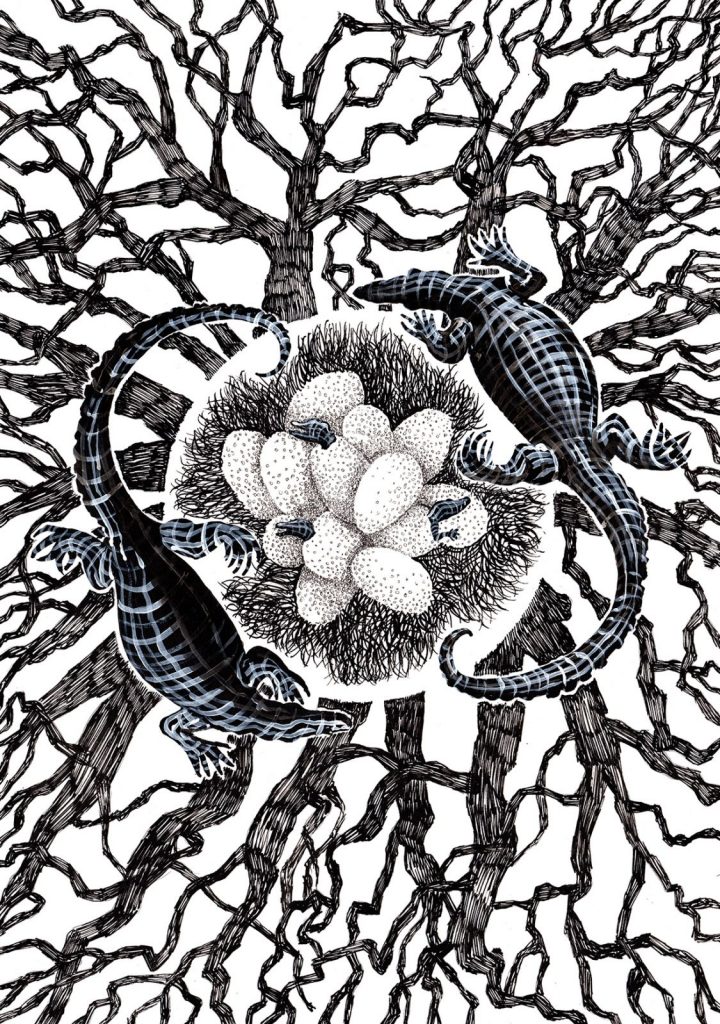
Nicky Laird 9:13
Great. That’s what I was gonna ask you and I’d seen some images on your website, I think. And I wanted to know whether you would explain that to people in the exhibition because it is fascinating to be able to then look at the work, for example, the work you’ve done like “Crocodile Eggs” and think that you could only actually use two textures.
Charlotte Orr 9:34
Thinking the exhibition I’ll have a little explanation underneath. And I think I’m also going to I have the original, just the 26 different marks. And I think it will be useful for people to say I was only allowed to use letters B, C, and whatever. There’s four different themes so I’ll tell you which letter corresponds with which image.
Nicky Laird 10:00
Sounds great. And how has it worked with the teachers you’ve had at Falmouth and learning from them because online being different?
Charlotte Orr 10:10
Yeah. Actually, the teachers of the tutors are really good. They’re all practicing illustrators themselves so they do some incredible work. But yeah, I think it’s a bit different. It’s a bit different working online in that I feel like I’m missing a connection with the other classmates actually because it’s supposed to be a flexible course you’re supposed to, you can drop in and out, you can watch things back at a later time. And often, I’m at work during the day, so I missed the live things but that means that you’re missing that interaction with other people as well. I think because of COVID, we haven’t been able to do the face to face meetups that they would usually do. So you would usually have mixed and made friends with people by now. So I think that’s the only downside for me at the moment that I hope that that will change for the second year anyway.
Nicky Laird 11:01
You’re also a teacher of Art and Design at City of Oxford College. Tell us a little bit more about your role there, what you teach, and also how do you think teaching influences your practice?
Charlotte Orr 11:12
So I teach students who are age 16+ and I mostly teach the practical skills, so printmaking, illustration, Photoshop – mostly the visual communication side of things because we also teach fashion design and photography and things, but that’s not really my specialism so there’s other teachers that do that. I find that it’s really actually I take a lot of inspiration from my students. I’ll give them the basics for how to do a process and then I’ll come back a few minutes later, and they’ve done something amazing that I hadn’t even thought of doing. So yeah, I’ve definitely stolen ideas from them in the past. I went into work the other day and one of the students had screen printed these really gorgeous patterns but they were so free in the way that they were painted. I hadn’t really thought of using the technique that she used but then after she’s gone, I was like, ‘Okay, I’m gonna have a go’ and tried it myself. So yeah, but mine didn’t have the same kind of freedom and character that hers had. So, I’m jealous.
Nicky Laird 12:30
That sounds like she’s going to be great. And that sounds like one way in which of course, it has influenced your practice, very directly from the work of a student. And I wonder just also in the way that you teach, whether that’s or what you teach, whether that’s steered you in one direction or another.
Charlotte Orr 12:49
Well, actually, interestingly, some of the projects that we teach it at the college have been sort of in line with some of the projects we’re working on in our MA. For example, we’ve just completed a map project, but we teach a mapping project at the college. So I knew quite a lot of artists to look at like Grayson Perry, and he does this really nice circular map. I also was inspired by a student who’d mapped out his own house but looking like sort of like a bird’s eye view and actually, I was like, ‘Oh, I could do this from my own project’ but I didn’t end up using it. But it’s definitely interesting to see how you can take inspiration from others, even though, I’m the teacher, but it doesn’t really matter. It’s a two-way street.
Nicky Laird 13:45
You mentioned this map project and that’s one of the projects that is going to be shown in the exhibition, so do you want to tell us a little bit about what to expect when we come?
Charlotte Orr 13:55
This map project is one of my most recent pieces. And I decided to do this quite a big long map of Oxford City centre, and it’s showing a greener Oxford. So I was researching on the Oxford City Council website, what the plans are for, you know, carbon neutral, and trying to create a better and more environmentally friendly city centre. I was also involved with (this was in 2019), I was involved with designing the kind of wrap arounds for recycling bins. So I featured them on the map as well. So I’ve kind of added lots of much more green to the city, urban gardens and things like that. I mean, it’s some of its realistic some of it’s probably not possible but I thought I would just mix it up a bit. And then I heard that actually the council are pedestrianising and putting in loads of seating onto Broad Street, and loads of green areas apparently for the summer. So I thought, ‘Oh, that’s actually in line with what I did on the map’.
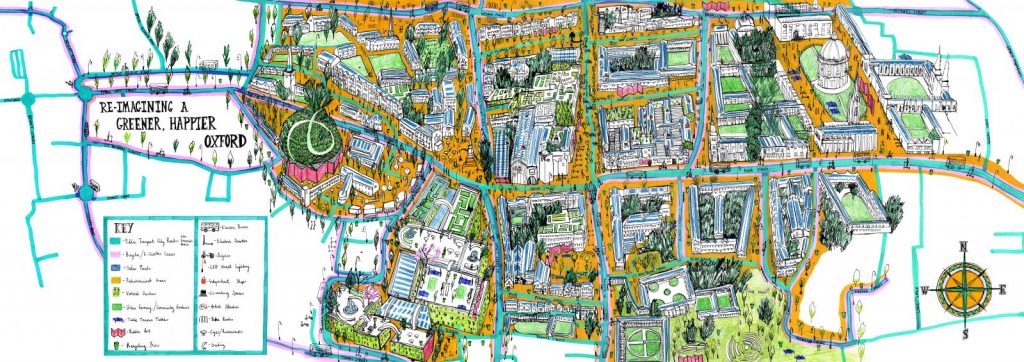
Nicky Laird 15:09
Sounds like you need to have another exhibition, an outdoor exhibition in the city centre, with all your ideas and see how they match up with what the council are going to do. What a wonderful idea.
Charlotte Orr 15:20
And actually, a few years back in 2015, I did a mural at the Oxford Castle and it was really long, like 14 metre mural painted, it took forever. But I was imagining those kinds of public art, but all over the city, not necessarily by me, but just by artists because I did research into how that affects people’s well being and feelings when they’re walking around the city centre. Apparently, it does have a big impact on how people feel, so lifts their mood and stuff like that.
Nicky Laird 15:46
You’re a very busy person but if you had nothing to do, what I’d suggest, and I’ve seen in in the city centre is there’s so many empty shop fronts. And they have started, there’s one in George Street, they have started to cover them up with the work of illustrators – one particularly opposite the New Theatre. And I just have this wonderful vision in my mind of you going and painting and illustrating the rest, which would be a wonderful project.
Charlotte Orr 16:24
I’ve seen the one is the one with the big heart opposite. Yeah, there’s a few actually. There’s a few also in East Oxford that I’ve been keeping an eye on because that’s where I live. So up along there, there’s quite a few that change quite often that have some really nice murals painted at the moment.
Nicky Laird 16:48
And as you say, I think it does affect how people feel when they walk through and Oxford has had its challenges in terms of the city centre and retail. And it’s just really rather depressing to see lots of empty shop fronts. And how wonderful would that be if there was more of that kind of work.
Charlotte Orr 17:04
Definitely.
Nicky Laird 17:05
Moving on from talking about Oxford. I’m quite intrigued by the time you spent living in Berlin. After you did your BA and before your MA, you’ve spent five years there. Can you tell us a little bit about your time there and the work you did while you were there?
Charlotte Orr 17:23
So I lived in Berlin, I can’t remember since 2014/2015. Because I studied German for A level and then I was doing work experience at a kindergarten. And I have a family friend that lives over there. And then I loved it so much that I just decided I wanted to go and stay there for a while, and ended up being a really long time. Yeah, I was teaching English in primary schools and then I was also doing my own freelance work on the side. And I had this amazing studio in an ex-Stasi building which was opposite Stasi prison, which is now a museum. But in the studio space that I had, that’s where they used to make all of the spy equipment for spying on people and stuff. So it’s really interesting history but like, when you’re looking out, you’re painting in your studio, and you’re looking out and people are having tours of the prison opposite and it was just a really unique space. But I decided because because all of my work was so small, I really wanted to do something a lot bigger because I had the space. So the lead image for this exhibition – and this is the oldest piece that’s going to be an exhibition so it’s I think it’s 2017 – was made in this studio. It’s quite botanical, it’s a forest scene basically but I’ve really got a lot of detail in it that you don’t necessarily see when you first look at the image. I was exploring quite a lot of different marks and I used acrylic and pen and ink. And there were a few spills but I was quite happy with the spills and I made the most out of them along the way. But it took months and months and months because it was so detailed.
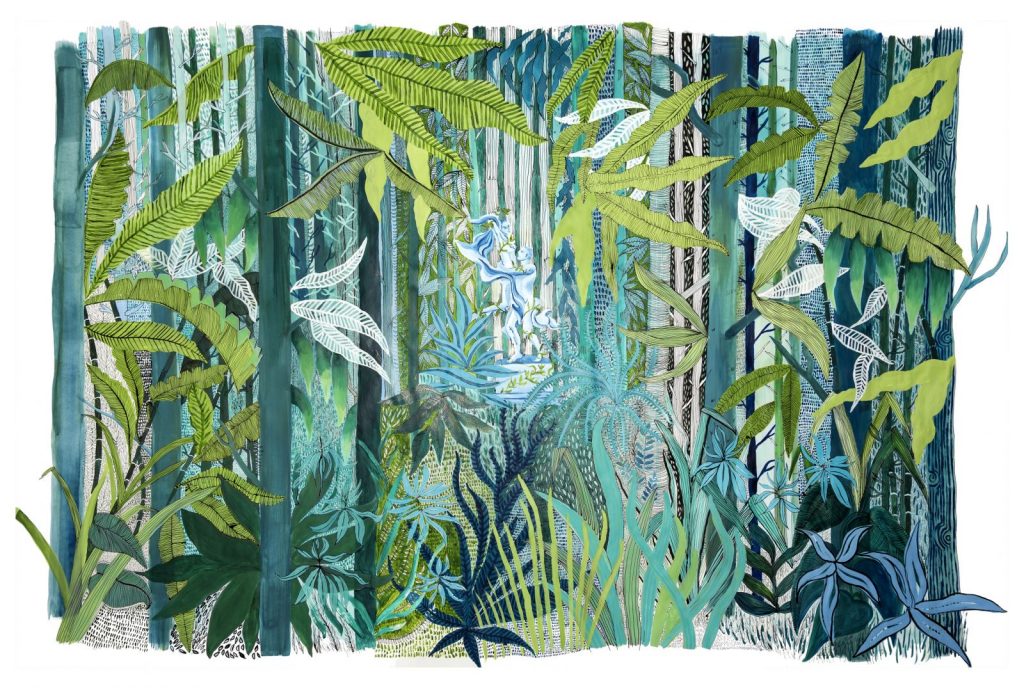
Nicky Laird 19:32
How interesting that you’ve just explained this vast studio space and the outlook you had on to the prison and the people coming to see the prison and also what that meant and the history and the context of that and yet here you were painting this beautiful botanical scene. And again, we’ve talked about you being very happy in Berlin, but it feels like you were somewhere else in your mind and back in nature which obviously is what this show is all about.
Charlotte Orr 20:02
Yeah, I really was. I think Berlin has a lot of green spaces as well, and I think had recently been to the Botanischer Garten in Berlin as well, and taken lots of inspiration from there, but most of that image was completely from my head. It didn’t have any references, really, apart from a few plants here and there.
Nicky Laird 20:27
How wonderful, I look forward to seeing that. There are other projects that we will see in the exhibition? And could you tell us a little bit more about them? I know you might show some of your sketchbooks. Just give us, as we close the interview today, a little glimpse into what else we’ll see. And then of course, we want people to actually see it for themselves.
Charlotte Orr 20:51
Yeah, so I’m going to display some of my sketchbooks. For the last module of my MA, the previous module, we were set the challenge of drawing every day. So it was from January to April. And we had to draw every day, although few days I missed out and then did it one day, but it’s okay. I think. So they’re going to be on show. There’s a lot of scenes of Oxford, but also just my desk, sitting at my desk, the view from my bedroom window, things like that.
I also got really into life drawing online during lockdown, which was really good actually. I actually got some right here but they can’t see this. But yeah, so I felt like it really freed up my because I wasn’t conscious of anyone else watching me because I was just at home on my own. But I actually felt so much better because often if I’ve gone to life drawing classes in real life, I’ve been really conscious of being quite out of practice, and other people being there. So, I got really into it, and really enjoyed doing that.
There are a few other things like the ‘Illuminated I’, which was another project I did for my MA, which was supposed to be about me and inspired by the Book of Kells in Dublin, it’s got like really a lot of intricate patterns and repeat patterns and archways and things like that. So I’ve tried to incorporate things I like in places that I like, interior design, about me, basically.
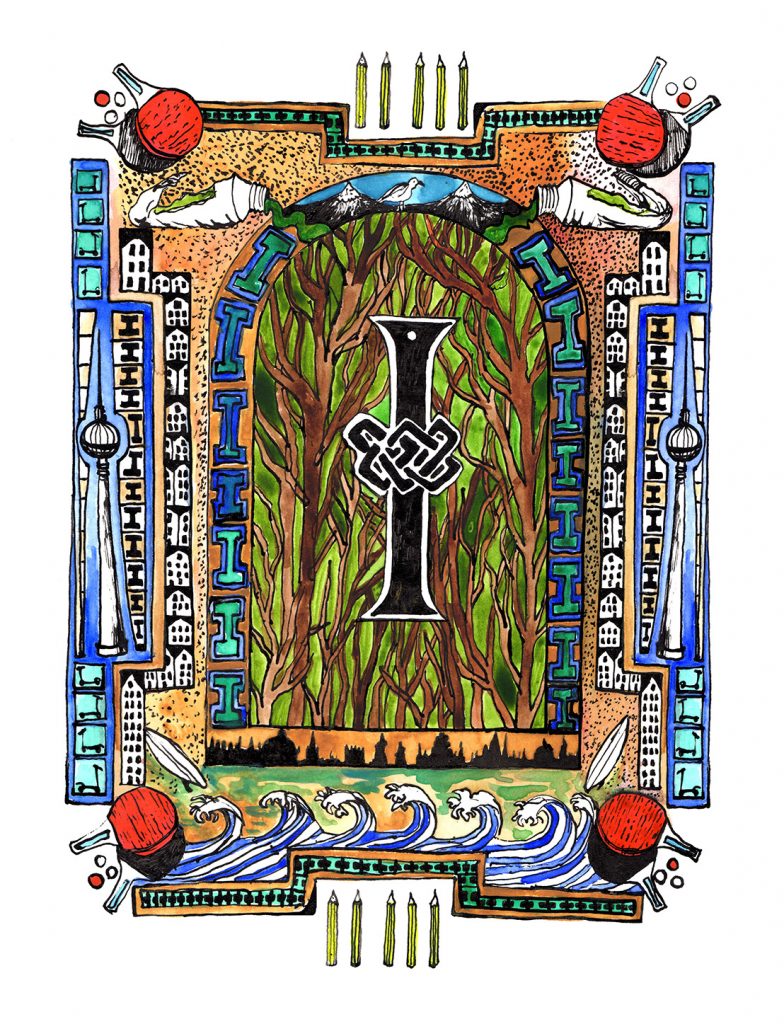
Nicky Laird 22:41
It’s hard. I mean, you’ve done so much work. I know that your dad was part of choosing works for the exhibition which is part of the reason why you’d like to dedicate to this to him.
Charlotte Orr 22:53
Yes. Well, I mean, he hoped he could be here for the exhibition itself. But sadly, he can’t. But he was actually I gave him a show at home not that long ago. And he was giving me some pointers and saying, ‘don’t use this, put this in’. I mean, he’s not an art critic or anything but he’d been really helpful and he’s also been a really huge support to me throughout everything.
Nicky Laird 23:18
How wonderful. We really looking forward to it. Charlotte. Thank you so much for being with us today and for those who are listening, Charlotte’s show will be on at The North Wall from the 7th – 24th July. Please make sure you come and visit.
Charlotte Orr 23:32
Thank you. Thanks for having me.
Amelia Thornber 23:46
Don’t forget to subscribe.
Kim Glassman 23:47
For more info on all of our upcoming live and digital events, head to our website www.thenorthwall.com.
Amelia Thornber 23:54
You can also follow @thenorthwall on all social media platforms.
Kim Glassman 23:58
Stay connected and until next time!

